Do you want to know the difference between a shank and a flank? Need some cooking tips for your succulent lamb roast? No problem! All you ever needed to know about lamb meat cuts is right here in our ultimate guide to types of lamb meat. Go beyond the rack of lamb and learn about this delicious meat.
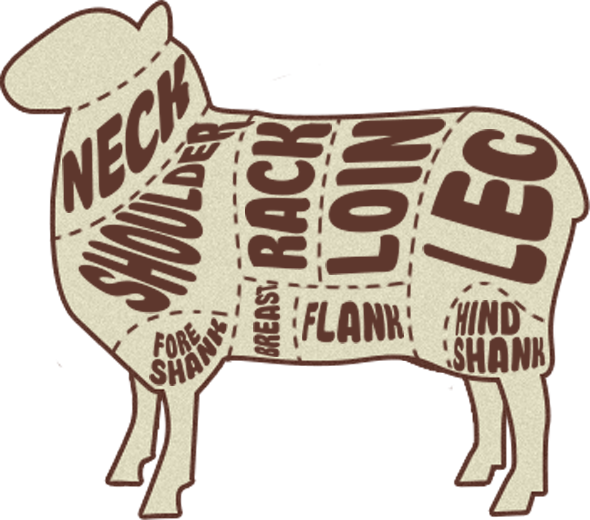
Main lamb primals.
A bit about lamb bits: the lamb, like most animals, is divided into primals, the main muscles where the most popular lamb cuts are cut from. The meat that comes from each primal has its own particular texture, flavor profile, and should be cooked accordingly. Read on and find out how to cook with different lamb cuts.
Lamb Primals
Lamb Shoulder
This large muscle is full of rich and sweet meat. Lamb shoulder steak can be presented whole, as a roast, or cut into steak-sized chops or diced for stew meat. Lamb shoulder meat has quite a bit of marbling, giving it flavor but also toughness and chew, so this is a cut that requires long cooking methods.
Cook: roast, braise, stew.
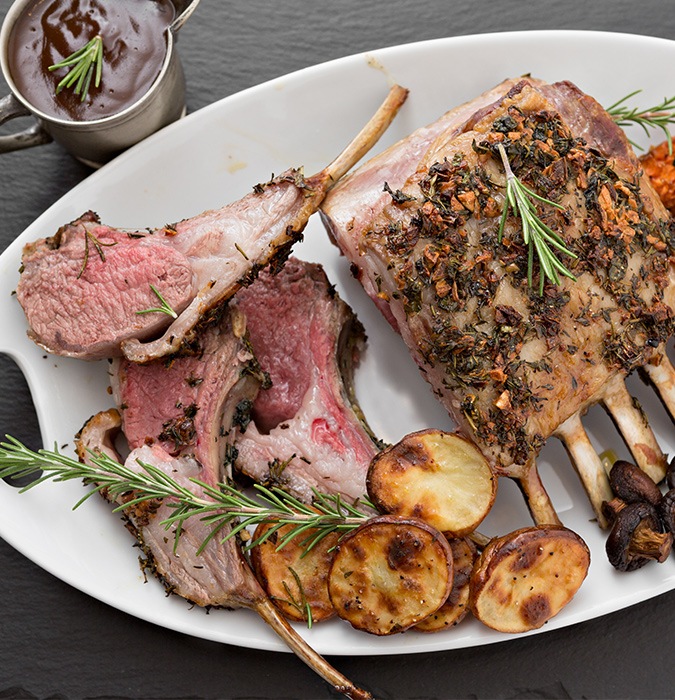
Lamb rib rack and lamb chops.
Lamb Rack
The main rib section of the lamb, the rack is made up 16 ribs, also called chops. Although it’s made up of two sections, each of 8 ribs, it is mostly sold halved. When sold whole, it’s called a double rack of lamb. A rack of lamb consists of tender, lean and flavorful meat as well as the rib bones. When the bones are exposed about 2 inches, the rack is called “Frenched”.
Cook: roast, grill, pan fry.
Lamb Loin (also Lamb Saddle)
The center of the animal, this contains the most tender cuts of lamb meat and is usually presented cut into loin chops or whole as a loin roast. Full of tender meat.
Cook: roast, grill, pan fry, braise.
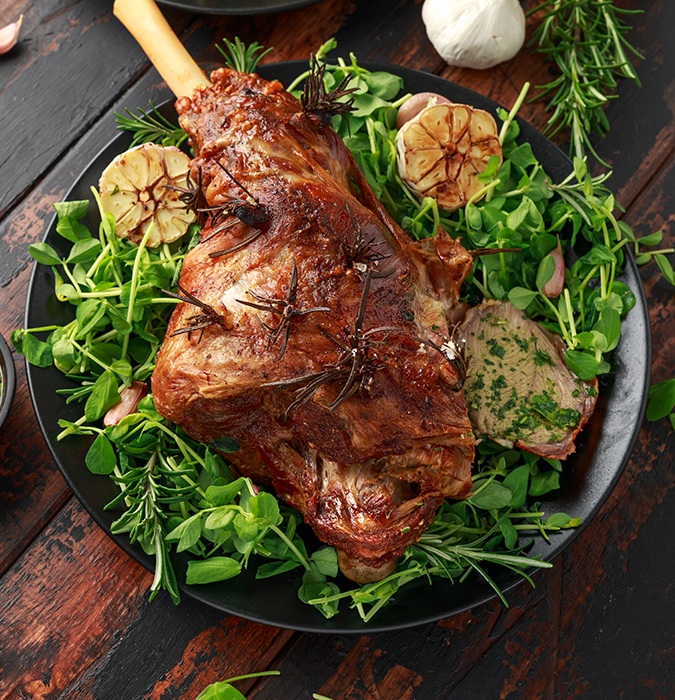
Lamb leg.
Lamb Leg
The back haunches of the lamb, presented bone in or boneless, the leg of lamb is a delicious classic cut. Sold whole or halved (the upper thigh), this is a large, flavorful cut that is very versatile. A bone in leg of lamb is usually more flavorful. Butterflied, it can be stuffed and rerolled.
Cook: roast, braise, bbq, grill. Cook to medium-rare.
Lamb Foreshank & Lamb Hindshank
From the lower portion of the leg, the shank is usually a hard-working muscle and requires long cooking times that breaks the tough meat into tender bites. The most commonly used is the foreshank.
Cook: braise, roast.
Lamb Breast
From the bottom of the lamb, the belly, comes the breast cut. It has a lot of fat and therefore a lot of chew, so lamb breast needs slow, long cooking to break down the toughness. Usually presented as a rolled joint, perfect for roasting.
Cook: braise, stew, roast.
Lamb Flank
This is the belly of the animal, a tough, fatty and flat cut that is usually reserved for stew and ground lamb meat, but also sometimes seen as lamb flank steaks. Lamb flank needs long cooking times.
Cook: braise, stew.
Lamb Neck
A very tough section of the animal, the neck does a lot of work, which makes it a cut that needs long, slow cooking. Usually available as thick neck slices, with or without the bone, it yields a fair amount of rich, marbled meat.
Cook: braise, stew.
Popular Lamb Meat Cuts
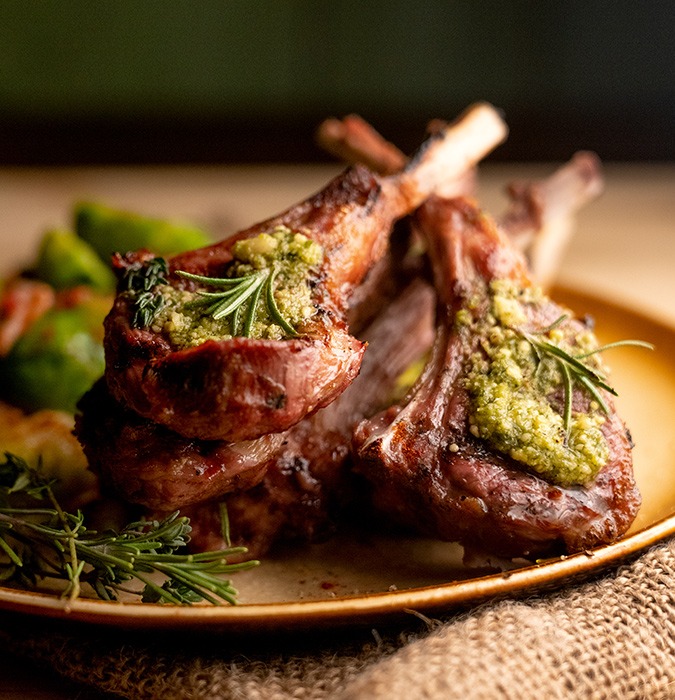
Lamb chops.
Lamb Chops:
Chops are portions of lamb meat that are cut different parts of the lamb, like shoulder chop, loin chop and blade chop. The texture, flavor and fat content will be different depending on the muscle that is comes from.
Loin Chop: From the most tender (and leanest) section of the lamb, loin chops have a nice portion of tenderloin and loin meat in them. They usually have a bone left in, which makes this cut look a bit like a t-bone steak.
Cook: grill, pan fry, roast. Best cooking point for loin chops is medium-rare.
Rib Chops:
Cut from the rack section of the lamb, rib chops are very tender and also very flavorful, thanks to a big swath of fat. Usually come with the bone. Not as meaty as loin chops, but with a smooth flavor.
Cook: Grill, braise, pan fry. Best to medium-rare.
Sirloin chop:
Cut from the back end of the lamb, these chops are not as tender as the loin or rib chops, but with less chew than shoulder chops.
Cook: grill, broil, braise, pan-fry.
Arm Shoulder Chop:
Larger than rib and loin chops, and with a bit more fat and chew, shoulder chops have a robust flavor. Good for marinating and then quick cooking.
Cook: marinade, pan fry, broil, braise. Use lower heat than rib or loin chops.
Blade Chop:
Ss their name implies, they’re cut from the shoulder blade area, but have a more fat than the arm shoulder chops.
Cook: grill, broil, pan fry, braise, roast.
Top Round:
Cut from the large top muscle of the leg, this is a tender cut that can be cut into steaks, or served whole as a top round lamb roast.
Cook: grill, pan fry, roast.
Stew Meat:
Although not technically a cut since it can come from any part of the animal, lamb stew meat is best when it comes from the flavorful shoulder. Long cooking times render it tender and mouthwatering.
Cook: stew.
Lamb Sirloin:
Between the loin and the leg, the lamb sirloin is usually presented with the whole lamb leg, but can also be sold separate, boneless as a sirloin roast, or cut into sirloin chops. Tender and flavorful.
Cook: roast, braise, bbq, grill (chops).
Lamb ribs or lamb riblets:
The bottom rib tips that are chopped off the breast when it’s cut into chops. Small but with a nice amount of meat to them, and have a cap of fat on one side.
Cook: Braise, BBQ, roast, slow grilled.
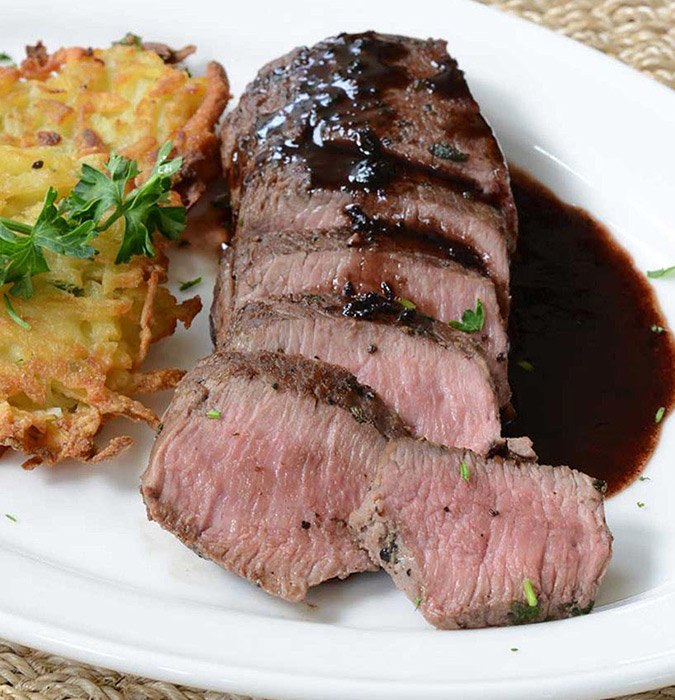
Boneless lamb loin.
Lamb Loin Roast:
When the loin muscle is not cut into chops, it’s called a loin roast. It can be presented with bones or boneless. Tender, lean.
Cook: roast, braise.
Neck Slices:
Cut from the neck area, these are usually presented in thick slices. Very tough, the neck has a good amount of collagen that dissolves as it is cooked, making this a great cut for slow cooking.
Cook: stew, braise.